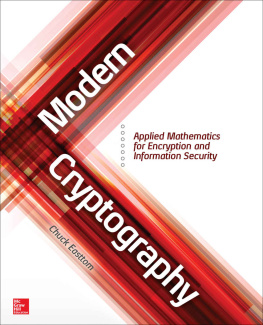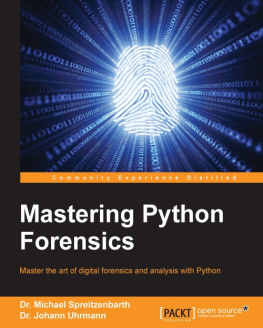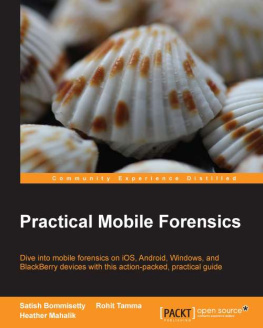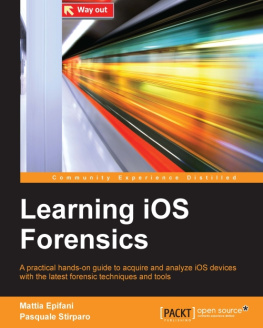Navigation
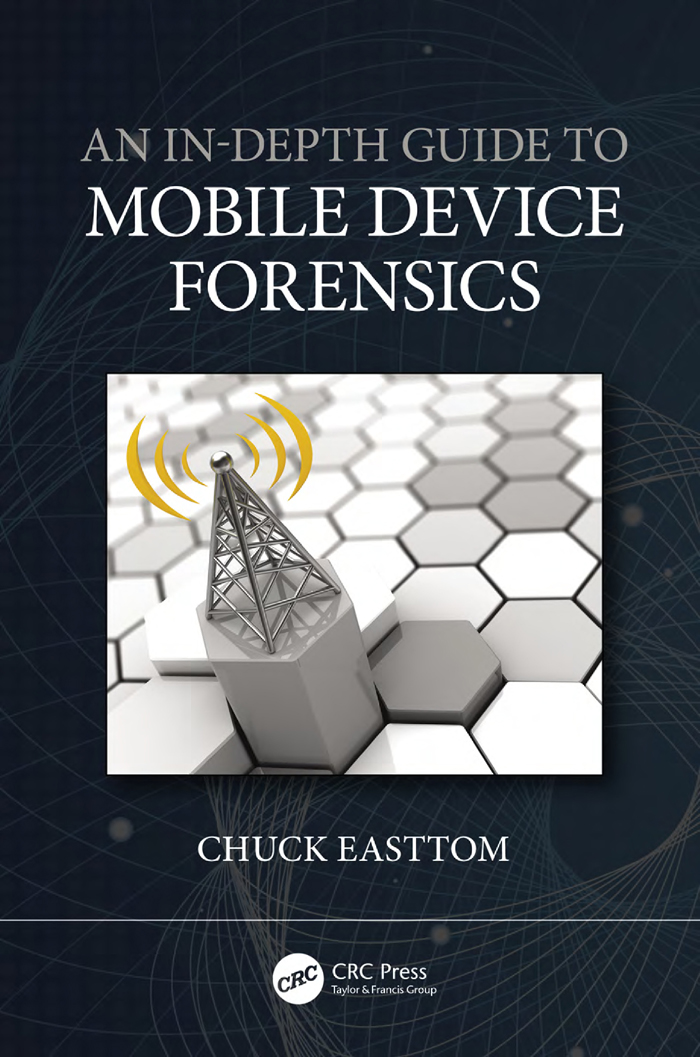
An In-Depth Guide To Mobile Device Forensics
An In-Depth Guide to Mobile Device Forensics
Chuck Easttom

First Edition published 2022
by CRC Press
6000 Broken Sound Parkway NW, Suite 300, Boca Raton, FL 33487-2742
and by CRC Press
2 Park Square, Milton Park, Abingdon, Oxon, OX14 4RN
2022 Taylor & Francis Group, LLC
CRC Press is an imprint of Taylor & Francis Group, LLC
The right of Chuck Easttom to be identified as author of this work has been asserted by him in accordance with sections 77 and 78 of the Copyright, Designs and Patents Act 1988.
Reasonable efforts have been made to publish reliable data and information, but the author and publisher cannot assume responsibility for the validity of all materials or the consequences of their use. The authors and publishers have attempted to trace the copyright holders of all material reproduced in this publication and apologize to copyright holders if permission to publish in this form has not been obtained. If any copyright material has not been acknowledged please write and let us know so we may rectify in any future reprint.
Except as permitted under U.S. Copyright Law, no part of this book may be reprinted, reproduced, transmitted, or utilized in any form by any electronic, mechanical, or other means, now known or hereafter invented, including photocopying, microfilming, and recording, or in any information storage or retrieval system, without written permission from the publishers.
For permission to photocopy or use material electronically from this work, access
Trademark notice: Product or corporate names may be trademarks or registered trademarks and are used only for identification and explanation without intent to infringe.
ISBN: 978-0-367-63298-4 (hbk)
ISBN: 978-0-367-63300-4 (pbk)
ISBN: 978-1-003-11871-8 (ebk)
DOI: 10.1201/9781003118718
Typeset in Times
by MPS Limited, Dehradun
Contents
DOI: 10.1201/9781003118718-1
Wireless communications are fundamental to cellular technology. That includes the essentialls of radio wave technology as well as cellullar networks. Cell networks including GSM, EDGE, UMTS, LTE, and 5G. There are other wireless technologies included in mobile phones. These technologies include 802.11 Wi-Fi as well as Bluetooth.
It should be relatively obvious that cell phones use wireless communications. However, we must be more specific in order to understand cellular technology. It is important to define the type of wireless communication in question. That will require us to examine how the electromagnetic waves themselves behave. Mobile forensics often focuses on just the device. And we will certainly be doing that in later chapters. However, it is important that you also understand the actual signals being transmitted. This chapter will provide a rigorous introduction to these topics so that you can better understand the cellular technology introduced in the rest of this book.
Wireless communication of any type requires using electromagnetic waves to transmit the signal. Our first goal will be to understand the electromagnetic spectrum, then we will delve into how to encode data in such transmissions. It is important to have a fundamental understanding of the basic physics of electromagnetic transmissions in order to understand precisely how mobile devices send and receive data.
Electromagnetic waves also known as electromagnetic radiation (EMR) are the waves of an electromagnetic field propagating through space. Such waves include visible light, radio waves, infrared and more. The complete spectrum of electromagnetic radiation is shown in .

Figure 1.1 The electromagnetic spectrum.
Notice that as the figure moves from left to right, the wavelength gets shorter, and thus the frequency gets longer. This is a fundamental fact about electromagnetic waves. They all travel at the same speed, the speed of light, which is approximately 300,000 km/second or 186,000 miles/second. Since the speed is constant, changing frequency or wavelength must change the other measurement proportionally. In you can see both wavelength and frequency illustrated.

Figure 1.2 Frequency and wavelength.
At the top you see a wave with a large wavelength. Note that both waves have the same total length. The wave on the top only has four peaks in this space of time, whereas the wave on the bottom has eleven peaks. Clearly the wave on the bottom has a higher frequency and shorter wavelength. It should also be noted that higher frequency means more energy. Consider again. With wavelengths on the order of 103 meters we have radio waves, which are not harmful. You encounter radio waves all the time. However, on the far right we have X-Rays with a wavelength of 108 meters and gamma rays with a wavelength of 1012 meters. These are both quite harmful. The relationship of frequency and wavelength is defined by this simple equation shown in (1.1):
f=c (1.1)
f is frequency
is wavelength
c is the speed of light
Radio transmission, as well as other types of electromagnetic radiation communication, works on the principle of producing a carrier wave as the means of communication between two wireless devices. The carrier wave is an electromagnetic wave of a particular frequency that is used to carry data. Technically you could use any frequency to encode and transmit data. However, for rather obvious reasons gamma rays and x-rays make a poor choice for communications. Frequency assignments are something you are likely to be familiar with. Radio and television broadcast stations are assigned specific frequencies on which they must transmit. A radio identification such as 101.1 FM represents a carrier wave of 101.1 MHz (megahertz). The frequency of 101.1 MHz also happens to be the frequency for the classical music station in my area.
It is important that you fully understand the hertz unit of measurement. A hertz is the international standard unit for frequency and is defined as one cycle per second. A cycle is moving from one peak to the next (or alternatively from one trough to the next) in a wave. A more formal definition is the number of oscillations per second. As you can see from the previous discussion of radio communication, we are normally discussing thousands or millions of cycles per second. Thus, we will usually talk about kilohertz (kHz), megahertz (MHz), gigahertz (GHz), or even terahertz (THz). Frequency is not only used for electromagnetic radiation, but also for sound waves. For example, an adult human, of normal hearing capacity, can detect sound between 20 Hz and 16,000 Hz. When you hear terms such as ultrasound, that literally means frequencies beyond normal human hearing (ultra). The American National Standards Institute has actually defined ultrasound as a bit higher than that, sound frequencies greater than 20 kHz or 20,000 Hz.
The carrier wave is encoded with data. This is done through some type of modulation


